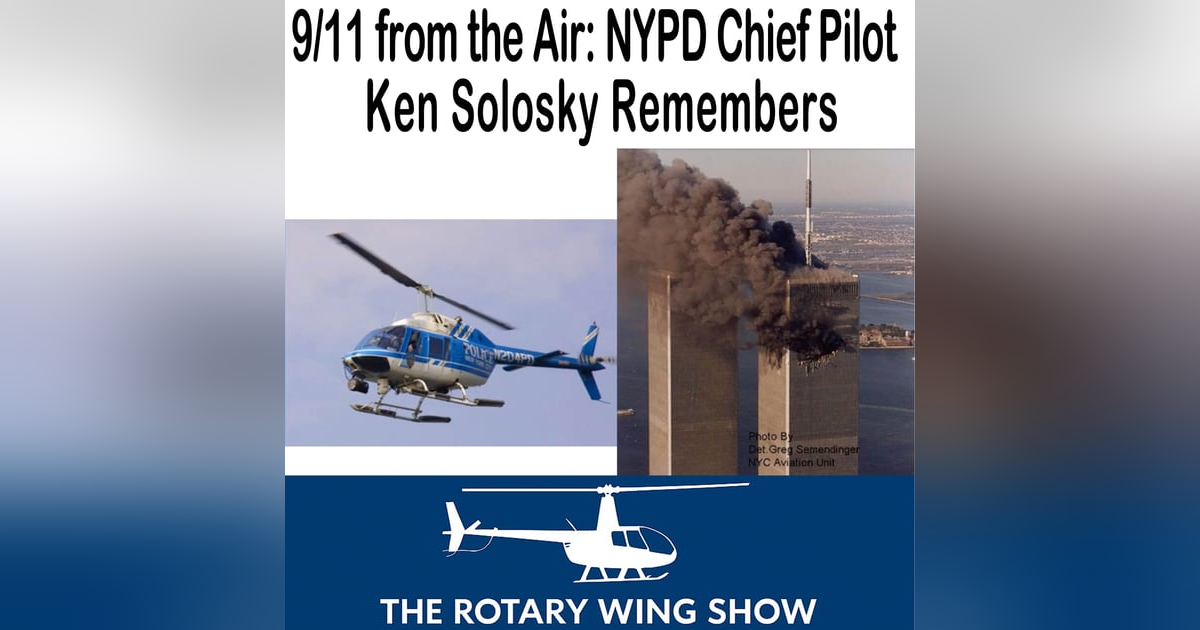9/11 from the Air: NYPD Chief Pilot Ken Solosky Remembers

Max Trescott talks with Ken Solosky, the NYPD's Chief Pilot on 9/11, about his experiences managing helicopter operations on one of the most catastrophic days in American history. Though Ken wasn’t flying at the moment of the attacks, he was on the ground coordinating the NYPD’s aviation response. He recounts how what began as a seemingly routine aircraft accident quickly escalated into a full-blown national emergency. The aviation unit scrambled a standard rescue package—Bell 412s with divers and crew chiefs, and patrol helicopters—only to face total communication breakdowns. Cell service and landlines failed, radio channels were overloaded, and misinformation, including reports of enemy fighter jets, created unprecedented confusion.
Ken recalls the surreal moment of watching the second plane hit the South Tower live on TV and initially being unable to process the reality. He explains why rooftop rescues weren’t feasible—smoke obscured visibility, doors were locked or inaccessible, and the risk of engine flameout in the intense heat made the mission too dangerous. Still, he and his team documented the scene extensively and continued daily aerial photography for nearly a year afterward.
Ken describes how foreign and domestic aviation units offered immediate support, with helicopters arriving from other cities—even LAPD offering to send their fleet. Yet due to lack of coordination, many of these aircraft were unknown to NYPD at the time and went unused in the response. He speaks candidly about the emotional toll, having lost 10 close friends among the 23 NYPD officers killed, and how that pain continues with the rise in 9/11-related cancer deaths among first responders.
Post-9/11, Ken was instrumental in implementing a “96-hour standalone” plan for the NYPD, designed to maintain operations without headquarters support. Staffing schedules were restructured to ensure long-term response capacity. He shares how the aviation unit has evolved over the years—growing from six helicopters to a modern fleet including Bell 429s, a Bell 407 trainer, and a fixed-wing Caravan used for radiation scanning of incoming ships to New York Harbor.
Ken also offers a detailed look at what a typical day is like for an NYPD pilot—flying patrol missions, conducting surveillance, responding to foot and vehicle pursuits, and supporting SWAT teams. He explains how the aircraft are equipped with cutting-edge tools like high-def thermal imagers, tactical radios, moving maps, and address-targeting cameras that can zoom in on a license plate from miles away. These tools enable precise coordination with ground teams and real-time intelligence, greatly improving safety and effectiveness.
The conversation also delves into pilot recruitment and training, safety management system (SMS) implementation, and Ken’s personal advice for those interested in joining a law enforcement aviation unit. He emphasizes that character and work ethic matter just as much as flight hours.
In lighter moments, Ken shares stories of flying Barbara Bush to West Point when Marine One had mechanical issues, and being told by Yankees legend Derek Jeter that flying for the NYPD was cooler than being the Yankees’ shortstop. He also describes dramatic rescues, like locating a man stranded on a sandbar after his friend swam off—and later finding that friend safe on another island.
Ken currently flies both a Bell 407 and an Augusta 109 for corporate clients and continues to teach and speak for the FAA and EAA. His legacy and continued contribution to aviation safety and training are evident throughout the episode. The interview is both a sobering reflection on 9/11 and a celebration of how aviation supports public safety in today’s complex world.
Mentioned on the Show:




